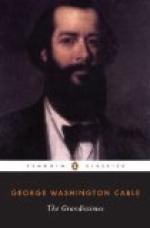As for the flesh, it was indeed only some of that “one flesh” of which we all are made; but the blood—to go into finer distinctions—the blood, as distinguished from the milk of her Alibamon foster-mother, was the blood of the royal caste of the great Toltec mother-race, which, before it yielded its Mexican splendors to the conquering Aztec, throned the jeweled and gold-laden Inca in the South, and sent the sacred fire of its temples into the North by the hand of the Natchez. For it is a short way of expressing the truth concerning Red Clay’s tissues to say she had the blood of her mother and the nerve of her father, the nerve of the true North American Indian, and had it in its finest strength.
As to her infantine bones, they were such as needed not to fail of straightness in the limbs, compactness in the body, smallness in hands and feet, and exceeding symmetry and comeliness throughout. Possibly between the two sides of the occipital profile there may have been an Incaean tendency to inequality; but if by any good fortune her impressible little cranium should escape the cradle-straps, the shapeliness that nature loves would soon appear. And this very fortune befell her. Her father’s detestation of an infant that had not consulted his wishes as to sex prompted a verbal decree which, among other prohibitions, forbade her skull the distortions that ambitious and fashionable Indian mothers delighted to produce upon their offspring.
And as to her brain: what can we say? The casket in which Nature sealed that brain, and in which Nature’s great step-sister, Death, finally laid it away, has never fallen into the delighted fingers—and the remarkable fineness of its texture will never kindle admiration in the triumphant eyes—of those whose scientific hunger drives them to dig for crania Americana; nor yet will all their learned excavatings ever draw forth one of those pale souvenirs of mortality with walls of shapelier contour or more delicate fineness, or an interior of more admirable spaciousness, than the fair council-chamber under whose dome the mind of Lufki-Humma used, about two centuries ago, to sit in frequent conclave with high thoughts.
“I have these facts,” it was Agricola Fusilier’s habit to say, “by family tradition; but you know, sir, h-tradition is much more authentic than history!”
Listening Crane, the tribal medicine-man, one day stepped softly into the lodge of the giant chief, sat down opposite him on a mat of plaited rushes, accepted a lighted calumet, and, after the silence of a decent hour, broken at length by the warrior’s intimation that “the ear of Raging Buffalo listened for the voice of his brother,” said, in effect, that if that ear would turn toward the village play-ground, it would catch a murmur like the pleasing sound of bees among the blossoms of the catalpa, albeit the catalpa was now dropping her leaves, for it was the moon of turkeys. No, it was the repressed laughter of squaws, wallowing with their young ones about the village pole, wondering at the Natchez-Tchoupitoulas child, whose eye was the eye of the panther, and whose words were the words of an aged chief in council.




